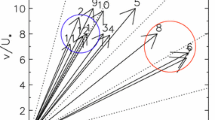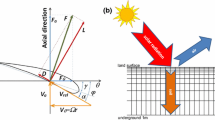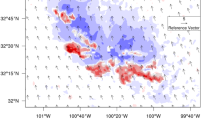Abstract
The effect of extensive terrestrial wind farms on the spatio-temporal structure of the diurnally-evolving atmospheric boundary layer is explored. High-resolution large-eddy simulations of a realistic diurnal cycle with an embedded wind farm are performed. Simulations are forced by a constant geostrophic velocity with time-varying surface boundary conditions derived from a selected period of the CASES-99 field campaign. Through analysis of the bulk statistics of the flow as a function of height and time, it is shown that extensive wind farms shift the inertial oscillations and the associated nocturnal low-level jet vertically upwards by approximately 200 m; cause a three times stronger stratification between the surface and the rotor-disk region, and as a consequence, delay the formation and growth of the convective boundary layer (CBL) by approximately 2 h. These perturbations are shown to have a direct impact on the potential power output of an extensive wind farm with the displacement of the low-level jet causing lower power output during the night as compared to the day. The low-power regime at night is shown to persist for almost 2 h beyond the morning transition due to the reduced growth of the CBL. It is shown that the wind farm induces a deeper entrainment region with greater entrainment fluxes. Finally, it is found that the diurnally-averaged effective roughness length for wind farms is much lower than the reference value computed theoretically for neutral conditions.














Similar content being viewed by others
References
Abkar M, Porté-Agel F (2013) The effect of free-atmosphere stratification on boundary-layer flow and power output from very large wind farms. Energies 6:2338–2361. doi:10.3390/en6052338
Abkar M, Porté-Agel F (2015a) Influence of atmospheric stability on wind-turbine wakes: a large-eddy simulation study. Phys Fluids 27(035104):1–19. doi:10.1063/1.4913695
Abkar M, Porté-Agel F (2015b) A new wind-farm parameterization for large-scale atmospheric models. J Renew Sustain Energy 7(1):013,121
Abkar M, Sharifi A, Porté-Agel F (2016) Wake flow in a wind farm during a diurnal cycle. J Turbul 17(4):420–441
Aitken ML, Kosović B, Mirocha JD, Lundquist JK (2014) Large eddy simulation of wind turbine wake dynamics in the stable boundary layer using the weather research and forecasting model. J Renew Sustain Energy 6(3):033,137
Albertson JD, Parlange MB (1999a) Natural integration of scalar fluxes from complex terrain. Water Resour Res 23:239–252
Albertson JD, Parlange MB (1999b) Surface length-scales and shear stress: implications for land–atmosphere interaction over complex terrain. Water Resour Res 35:2121–2131
Baker RW, Walker SN (1984) Wake measurements behind a large horizontal axis wind turbine generator. Sol Energy 33(1):5–12. doi:10.1016/0038-092X(84)90110-5
Banta R, Newsom R, Lundquist J, Pichugina Y, Coulter R, Mahrt L (2002) Nocturnal low-level jet characteristics over kansas during cases-99. Boundary-Layer Meteorol 105(2):221–252
Barrie D, Kirk-Davidoff D (2010) Weather response to a large wind turbine array. Atmos Chem Phys 10(2):769–775
Barthelemie RJ, Jensen L (2010) Evaluation of wind farm efficiency and wind turbine wakes at the Nysted offshore wind farm. Wind Energy 13:573–586
Barthelmie RJ, Rathmann O, Frandsen ST, Hansen KS, Politis E, Prospathopoulos J, Rados K, Cabezón D, Schlez W, Phillips J, Neubert a, Schepers JG, Pijl SPVD (2007) Modelling and measurements of wakes in large wind farms. J Phys Conf Ser 75(012):049. doi:10.1088/1742-6596/75/1/012049
Barthelmie RJ, Hansen K, Frandsen ST, Rathmann O, Schepers JG, Schlez W, Phillips J, Rados K, Zervos a, Politis ES, Chaviaropoulos PK (2009) Modelling and measuring flow and wind turbine wakes in large wind farms offshore. Wind Energy 12(June):431–444. doi:10.1002/we.348
Barthelmie RJ, Pryor SC, Frandsen ST, Hansen KS, Schepers JG, Rados K, Schlez W, Neubert a, Jensen LE, Neckelmann S (2010) Quantifying the impact of wind turbine wakes on power output at offshore wind farms. J Atmos Ocean Technol 27(8):1302–1317. doi:10.1175/2010JTECHA1398.1
Basu S, Vinuesa JF, Swift A (2008) Dynamic LES modeling of a diurnal cycle. J Appl Meteorol Clim 47(4):1156–1174
Bhaganagar K, Debnath M (2015) The effects of mean atmospheric forcings of the stable atmospheric boundary layer on wind turbine wake. J Renew Sustain Energy 7(1):013124
Blackadar AK (1957) Boundary layer wind maxima and their significance for the growth of nocturnal inversions. Bull Am Meteorol Soc 38(5):283–290
Bou-Zeid E, Meneveau C, Parlange MB (2005) A scale-dependent Lagrangian dynamic model for large-eddy simulation of complex turbulent flows. Phys Fluids 17:1–18
Brutsaert W (1992) Stability correction functions for the mean wind speed and temperature in the unstable surface layer. Geophys Res Lett 19(5):469–472. doi:10.1029/92GL00084
Brutsaert W, Gash J, Parlange MB (1989) Neutral humidity profiles in the boundary layer and regional evaporation from sparse pine forest. Ann Geophys 7:623–630
Cal RB, Lebrón J, Castillo L, Kang HS, Meneveau C (2010) Experimental study of the horizontally averaged flow structure in a model wind-turbine array boundary layer. J Renew Sustain Energy 2(1):013,106
Calaf M, Meyers J, Meneveau C (2010) Large eddy simulation study of fully developed wind-turbine array boundary layers. Phys Fluids 22(015110):1–16
Calaf M, Parlange MB, Meneveau C (2011) Large eddy simulation of scalar transport in fully developed wind-turbine array boundary layers. Phys Fluids 23(126603):1–16
Calaf M, Higgins C, Parlange MB (2014) Large wind farms and the scalar flux over an heterogeneously rough land surface. Boundary-Layer Meteorol 153(3):471–495
Canuto C, Hussaini MY, Quarteroni A, Zang TA (1988) Fundamentals of spectral methods for PDEs. In: Spectral methods in fluid dynamics, Chap 3. Springer, Berlin, pp 76–93
Chiba O, Kobayashi S (1986) A study of the structure of low-level katabatic winds at Mizuho Station, east Antarctica. Boundary-Layer Meteorol 37(4):343–355
Churchfield MJ, Lee S, Michalakes J, Moriarty PJ (2012) A numerical study of the effects of atmospheric and wake turbulence on wind turbine dynamics. J Turbul 13(February 2015):N14. doi:10.1080/14685248.2012.668191
Derbyshire SH (1990) Nieuwstadt’s stable boundary layer revisited. Q J R Meteorol Soc 116(491):127–158
Emeis S, Frandsen S (1993) Reduction of horizontal wind speed in a boundary layer with obstacles. Boundary-Layer Meteorol 64(1980):297–305. doi:10.1007/BF00708968
Finnigan J (2000) Turbulence in plant canopies. Annu Rev Fluid Mech 32(1):519–571
Fitch AC, Olson JB, Lundquist JK, Dudhia J, Gupta AK, Michalakes J, Barstad I (2012) Local and mesoscale impacts of wind farms as parameterized in a mesoscale NWP model. Mon Weather Rev 140(9):3017–3038
Fitch AC, Lundquist JK, Olson JB (2013a) Mesoscale influences of wind farms throughout a diurnal cycle. Mon Weather Rev 141(7):2173–2198
Fitch AC, Olson JB, Lundquist JK, Dudhia J, Gupta AK, Michalakes J, Barstad I (2013b) Local and mesoscale impacts of wind farms as parametrized in a mesoscale NWP model. Mon Weather Rev 140:3017–3038
Frandsen S (1992) On the wind speed reduction in the center of large clusters of wind turbines. J Wind Eng Ind Aerodyn 39:251–265
Frandsen S, Barthelmie R, Pryor S, Rathmann O, Sr Larsen, Højstrup J, Thøgersen M (2006) Analytical modelling of wind speed deficit in large offshore wind farms. Wind Energy 9:39–53. doi:10.1002/we.189
Frigo M, Johnson S (2005) The design and implementation of FFTW3. Proc IEEE 93(2):216–231
Giometto MG, Christen A, Meneveau C, Fang J, Krafczyk M, Parlange MB (2016) Spatial characteristics of roughness sublayer mean flow and turbulence over a realistic urban surface. Boundary-Layer Meteorol 1–28. doi:10.1007/s10546-016-0157-6
Hancock P, Pascheke F (2010) Wind tunnel simulations of wind turbine wake interactions in neutral and stratified wind flow. In: 10th EMS annual meeting, 10th European conference on applications of meteorology (ECAM)
Higgins C, Vache K, Calaf M, Hassanpour E, Parlange MB (2015) Wind turbines and water in irrigated areas. Agric Water Manag 152:299–300. doi:10.1016/j.agwat.2014.11.016. http://linkinghub.elsevier.com/retrieve/pii/S0378377414003771
Hultmark M, Calaf M, Parlange MB (2013) A new wall shear stress model for atmsopheric boundary layer. J Atmos Sci 70:3460–3470
Iungo GV, Porté-Agel F (2014) Volumetric LiDAR scanning of wind turbine wakes under convective and neutral atmospheric stability regimes. J Atmos Ocean Technol 31(10):2035–2048. doi:10.1175/JTECH-D-13-00252.1
Jensen N (1983) A note on wind generator interaction. Risø-M No. 2411, pp 1–16
Katic I, Højstrup J, Jensen NO (1986) A simple model for cluster efficiency. In: European Wind Energy Association conference and exhibition, pp 407–410
Keck RE, Maré M, Churchfield MJ, Lee S, Larsen G, Madsen HA (2014) On atmsopheric stability in the dynamic wake meandering model. Wind Energy 17:1689–1710
Keith D, DeCarolis J, Denkenberger D, Lenschow D, Malyshev S, Pacala S, Rasch P (2004) The influence of large-scale wind power on global climate. Proc Natl Acad Sci USA 101(46):16,115–16,120
Kirk-Davidoff DB, Keith DW (2008) On the climate impact of surface roughness anomalies. J Atmos Sci 65:2215–2234
Kumar V, Svensson G, Holtslag A, Meneveau C, Parlange MB (2010) Impact of surface flux formulations and geostrophic forcing on large-eddy simulations of diurnal atmospheric boundary layer flow. J Appl Meteorol Clim 49(7):1496–1516
Lissaman PBS (1979) Energy effectiveness of arbitrary arrays of wind turbines. J Energy 3(6):323–328
Lu H, Porté-Agel F (2011) Large-eddy simulation of a very large wind farm in a stable atmospheric boundary layer. Phys Fluids 23(065101):1–19
Lu H, Porté-Agel F (2015) On the impact of wind farms on a convective atmospheric boundary layer. Boundary-Layer Meteorol 157(1):81–96
Magnusson M, Smedman AS (1994) Influence of atmospheric stability on wind-turbine wakes. Wind Energy 18:139–152
Mahrt L, Lenschow D (1976) Growth dynamics of the convectively mixed layer. J Atmos Sci 33(1):41–51
Markfort CD, Zhang W, Porté-Agel F (2012) Turbulent flow and scalar transport through and over aligned and staggered wind farms. J Turbul 13(1):N33
Meneveau C (2012) The top-down model of wind farm boundary layers and its applications. J Turbul 13:N7. doi:10.1080/14685248.2012.663092
Meyers J, Meneveau C (2010) Large eddy simulations of large wind-turbine arrays in the atmospheric boundary layer. In: 48th AIAA aerospace sciences meeting including the new horizons forum and aerospace exposition
Moeng CH (1984) A large-eddy simulation model for the study of planetary boundary-layer turbulence. J Amtos Sci 41:2052–2062
Monin A, Obukhov A (1954) Basic laws of turbulent mixing in the ground layer of the atmsophere. Tr Geofiz Int Akad Nauk SSSR 151:163–187
Nieuwstadt F, Brost R (1986) The decay of convective turbulence. J Atmos Sci 43(6):532–546
Oldroyd HJ, Katul G, Pardyjak ER, Parlange MB (2014) Momentum balance of katabatic flow on steep slopes covered with short vegetation. Geophys Res Lett 41(13):4761–4768
Peña A, Rathmann O (2014) Atmospheric stability-dependent infinite wind-farm models and the wake-decay coefficient. Wind Energy 17(8):1269–1285
Porté-Agel F, Wu YT, Chen CH (2013) A numerical study of the effects of wind direction on turbine wakes and power losses in a large wind farm. Energies 6(10):5297–5313. doi:10.3390/en6105297
Poulos GS, Blumen W, Fritts DC, Lundquist JK, Sun J, Burns SP, Nappo C, Banta R, Newsom R, Cuxart J et al (2002) Cases-99: a comprehensive investigation of the stable nocturnal boundary layer. Bull Am Meteorol Soc 83(4):555–581
Povitsky A, Morris PJ (2000) A higher-order compact method in space and time based on parallel implementation of the Thomas algorithm. J Comput Phys 161(1):182–203
Roy SB (2011) Simulating impacts of wind farms on local hydrometeorology. J Wind Eng Ind Aerodyn 99:491–498
Roy SB, Traiteur JJ (2010) Impacts of wind farms on surface air temperatures. Proc Natl Acad Sci USA 107(42):17,899–17,904
Sescu A, Meneveau C (2015) Large-eddy simulation and single-column modeling of thermally stratified wind turbine arrays for fully developed, stationary atmospheric conditions. J Atmos Ocean Technol 32(6):1144–1162
Shapiro A, Fedorovich E (2009) Nocturnal low-level jet over a shallow slope. Acta Geophys 57(4):950–980
Sharma V, Calaf M, Lehning M, Parlange MB (2015) An LES model for a time-adaptive wind turbine. Wind Energy. doi:10.1002/we.1877
Shin HH, Hong SY (2011) Intercomparison of planetary boundary-layer parametrizations in the WRF model for a single day from CASES-99. Boundary-Layer Meteorol 139(2):261–281
Sorbjan Z (1997) Decay of convective turbulence revisited. Boundary-Layer Meteorol 82(3):503–517
Stensrud DJ (1996) Importance of low-level jets to climate: a review. J Clim 9(8):1698–1711
Stevens RJAM, Gayme DF, Meneveau C (2014) Large eddy simulation studies of the effects of alignment and wind farm length. J Renew Sustain Energy 6(2):023105
Sun WY, Ogura Y (1980) Modeling the evolution of the convective planetary boundary layer. J Atmos Sci 37(7):1558–1572
Svensson G, Holtslag A, Kumar V, Mauritsen T, Steeneveld G, Angevine W, Bazile E, Beljaars A, de Bruijn E, Cheng A, Conangla L, Cuxart J, Ek M, Falk MJ, Freedman F, Kitagawa H, Larson VE, Lock A, Mailhot J, Masson V, Park S, Pleim J, Söderberg S, Weng W, Zampieri M (2011) Evaluation of the diurnal cycle in the atmospheric boundary layer over land as represented by a variety of single-column models: the second GABLS experiment. Boundary-Layer Meteorol 140(2):177–206
Tseng YH, Meneveau C, Parlange MB (2006) Modeling flow around bluff bodies and predicting urban dispersion using large eddy simulation. Environ Sci Technol 40(8):2653–2662
Wang C, Prinn RG (2010) Potential climatic impacts and reliability of very large-scale wind farms. Atmos Chem Phys 10(4):2053–2061
Whiteman CD, Bian X, Zhong S (1997) Low-level jet climatology from enhanced rawinsonde observations at a site in the southern great plains. J Appl Meteorol 36(10):1363–1376
Wu YT, Porté-Agel F (2011) Large-eddy simulation of wind-turbine wakes: evaluation of turbine parametrizations. Boundary-Layer Meteorol 138:345–366. doi:10.1007/s10546-010-9569-x
Wyngaard JC (2010) Turbulence in the atmosphere. Cambridge University Press, Cambridge, 406 pp
Wyngaard JC, Coté O (1974) The evolution of a convective planetary boundary layer—a higher-order-closure model study. Boundary-Layer Meteorol 7(3):289–308
Xia G, Zhou L, Freedman JM, Roy SB, Harris RA, Cervarich MC (2015) A case study of effects of atmospheric boundary layer turbulence, wind speed, and stability on wind farm induced temperature changes using observations from a field campaign. Clim Dyn 46(7):2179–2196
Zhang W, Markfort CD, Porté-Agel F (2013) Experimental study of the impact of large-scale wind farms on land–atmosphere exchanges. Environ Res Lett 8(015002):1–8. doi:10.1088/1748-9326/8/1/015002
Zhou L, Tian Y, Roy SB, Thorncroft C, Bosart LF, Hu Y (2012) Impacts of wind farms on land surface temperature. Nature Clim Change 2(7):539–543
Acknowledgments
The authors would like to thank Dr. Oldroyd for reading the manuscript and providing valuable comments. The work was made possible by support received through the Swiss National Science Foundation (Project No. 200021134892/1 and 20020 125092), ETH Domain Centre for Competence in Environmental Sustainability, NSERC Discovery Grant (MBP), Swiss National Supercomputing Center (CSCS), Scientific IT and Application Support (SCITAS) group at EPFL, University of Utah and University of British Columbia.
Author information
Authors and Affiliations
Corresponding author
Rights and permissions
About this article
Cite this article
Sharma, V., Parlange, M.B. & Calaf, M. Perturbations to the Spatial and Temporal Characteristics of the Diurnally-Varying Atmospheric Boundary Layer Due to an Extensive Wind Farm. Boundary-Layer Meteorol 162, 255–282 (2017). https://doi.org/10.1007/s10546-016-0195-0
Received:
Accepted:
Published:
Issue Date:
DOI: https://doi.org/10.1007/s10546-016-0195-0




